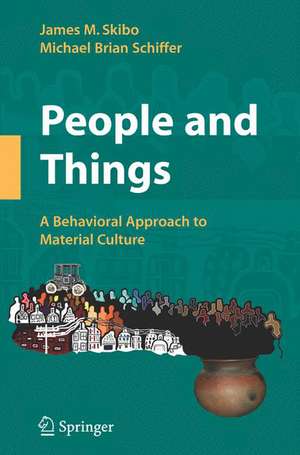People and Things: A Behavioral Approach to Material Culture
Autor James M. Skibo, Michael Brian Schifferen Limba Engleză Paperback – 14 oct 2008
| Toate formatele și edițiile | Preț | Express |
|---|---|---|
| Paperback (1) | 429.10 lei 6-8 săpt. | |
| Springer – 14 oct 2008 | 429.10 lei 6-8 săpt. | |
| Hardback (1) | 389.11 lei 6-8 săpt. | |
| Springer – 7 mar 2008 | 389.11 lei 6-8 săpt. |
Preț: 429.10 lei
Nou
Puncte Express: 644
Preț estimativ în valută:
82.12€ • 89.17$ • 68.98£
82.12€ • 89.17$ • 68.98£
Carte tipărită la comandă
Livrare economică 23 aprilie-07 mai
Preluare comenzi: 021 569.72.76
Specificații
ISBN-13: 9780387771328
ISBN-10: 0387771328
Pagini: 170
Ilustrații: XIII, 170 p. 16 illus.
Dimensiuni: 155 x 235 x 10 mm
Greutate: 0.6 kg
Ediția:2008
Editura: Springer
Colecția Springer
Locul publicării:New York, NY, United States
ISBN-10: 0387771328
Pagini: 170
Ilustrații: XIII, 170 p. 16 illus.
Dimensiuni: 155 x 235 x 10 mm
Greutate: 0.6 kg
Ediția:2008
Editura: Springer
Colecția Springer
Locul publicării:New York, NY, United States
Public țintă
GraduateCuprins
People and Things: A Performance-Based Theory.- Behavior, Selection, Agency, Practice, and Beyond.- The Origins of Pottery on the Colorado Plateau.- Smudge Pits and Hide Smoking.- The Devil is in the Details.- Ritual Performance: Ball Courts and Religious Interaction.- Social Theory and History in Behavioral Archaeology: Gender, Social Class, and the Demise of the Early Electric Car.- Studying Technological Differentiation.
Textul de pe ultima copertă
People and Things: A Behavioral Approach to Material Culture
James M. Skibo, Department of Anthropology, University of Illinois, Normal, IL
Michael B. Schiffer, Department of Anthropology, University of Arizona, Tucson, AZ
The core of archaeology is the relationship between people and things. Left without informants and, in many cases, textual data, archaeologists strive to reconstruct past life through the window of artifacts: things made, used, and modified by individuals while participating in the activities of everyday life. According to behavioral archaeologists, our ability to understand the relationship between people and things in the present is the foundation for archaeological reconstruction of the past.
This comprehensive text sets forth a theory for understanding the relationship between people and things. Humans, whether in the distant past or in our current world, make choices while inventing, developing, replicating, adopting, and using their technologies. A wide arc of factors, from utilitarian to social and religious can affect these choices. The theoretical model presented here provides the means to understand how people, whether it be Paleolithic stone tool makers or 21st century computer designers and users, negotiate these myriad factors throughout the artifact’s life history. While setting forth a behavioral theory, the book also engages the ideas of other competing theories, focusing especially on agency, practice, and selectionism.
Six case studies form the core of the book, and provide clear examples of how the theory can be applied to a range of artifacts and people from prehistoric North American ball courts and smudge pits to the first electric cars and 19th century electromagnetic telegraph technologies. This book provides the reader, for the first time between two covers, a wide array of examples that can guide their own work.
Archaeology and anthropology graduate students will find this book of interest. Twenty years in the making, this work will be an essential tool for new scholars as well as experienced members in the field of archaeology or any researcher who investigates technology.
James M. Skibo, Department of Anthropology, University of Illinois, Normal, IL
Michael B. Schiffer, Department of Anthropology, University of Arizona, Tucson, AZ
The core of archaeology is the relationship between people and things. Left without informants and, in many cases, textual data, archaeologists strive to reconstruct past life through the window of artifacts: things made, used, and modified by individuals while participating in the activities of everyday life. According to behavioral archaeologists, our ability to understand the relationship between people and things in the present is the foundation for archaeological reconstruction of the past.
This comprehensive text sets forth a theory for understanding the relationship between people and things. Humans, whether in the distant past or in our current world, make choices while inventing, developing, replicating, adopting, and using their technologies. A wide arc of factors, from utilitarian to social and religious can affect these choices. The theoretical model presented here provides the means to understand how people, whether it be Paleolithic stone tool makers or 21st century computer designers and users, negotiate these myriad factors throughout the artifact’s life history. While setting forth a behavioral theory, the book also engages the ideas of other competing theories, focusing especially on agency, practice, and selectionism.
Six case studies form the core of the book, and provide clear examples of how the theory can be applied to a range of artifacts and people from prehistoric North American ball courts and smudge pits to the first electric cars and 19th century electromagnetic telegraph technologies. This book provides the reader, for the first time between two covers, a wide array of examples that can guide their own work.
Archaeology and anthropology graduate students will find this book of interest. Twenty years in the making, this work will be an essential tool for new scholars as well as experienced members in the field of archaeology or any researcher who investigates technology.
Caracteristici
Definitive guide to the theory of behavioral archaeology First time these six diverse case studies have been published together Compares and contrasts behavioral archaeology with other prevailing theoretical models to fully explain the theory Includes supplementary material: sn.pub/extras









